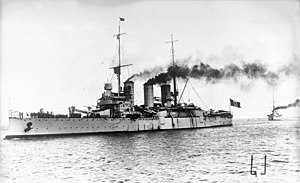
Back طراد بيزا المدرع Arabic Броненосни крайцери тип „Пиза“ Bulgarian Třída Pisa Czech Pisa-Klasse German Clase Pisa Spanish ناو کلاس پیزا FA Pisa-luokka Finnish Classe Pisa French Classe Pisa Italian ピサ級装甲巡洋艦 Japanese
 Pisa in February 1932, showing the foremast added in the 1920s
| |
| Class overview | |
|---|---|
| Name | Pisa |
| Operators | |
| Preceded by | Giuseppe Garibaldi class |
| Succeeded by | San Giorgio class |
| Subclasses | Georgios Averof |
| Built | 1905–1909 |
| In commission | 1909–1952 |
| Completed | 3 |
| Lost | 1 |
| Scrapped | 1 |
| Preserved | 1 |
| General characteristics | |
| Type | Armored cruiser |
| Displacement | 9,832 t (9,677 long tons) |
| Length | 140.5 m (460 ft 11 in) (o/a) |
| Beam | 21 m (68 ft 11 in) |
| Draft | 6.9–7.1 m (22 ft 8 in – 23 ft 4 in) |
| Installed power |
|
| Propulsion | 2 shafts, 2 vertical triple-expansion steam engines |
| Speed | 23 knots (43 km/h; 26 mph) |
| Range | 2,500 nmi (4,600 km; 2,900 mi) at 12 knots (22 km/h; 14 mph) |
| Complement | 32 officers, 652–55 enlisted men |
| Armament |
|
| Armor |
|
The Pisa class consisted of three armored cruisers built in Italy in the first decade of the 20th century. Two of these were for the Royal Italian Navy (Regia Marina) and the third was sold to the Royal Hellenic Navy and named Georgios Averof. This ship served as the Greek flagship for the bulk of her active career and participated in the Balkan Wars of 1912–1913, fighting in two battles against the Ottoman Navy. She played a minor role in World War II after escaping from Greece during the German invasion in early 1941. Influenced by communist agitators, her crew mutinied in 1944, but it was suppressed without any bloodshed. Georgios Averof returned to Greece after the German evacuation in late 1944 and became a museum ship in 1952. She is the only surviving armored cruiser in the world.[1]
The two Italian ships participated in the Italo-Turkish War of 1911–1912 during which they supported ground forces in Libya with naval gunfire and helped to occupy towns in Libya and islands in the Dodecanese. They played a minor role in World War I after a submarine sank Amalfi shortly after Italy joined the war in 1915. Her sister ship, Pisa, became a training ship after the war and was broken up for scrap in 1937.
- ^ Carr, p. 9